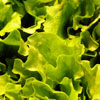Puree cherimoya flesh in a blender, then add remaining ingredients and mix thoroughly. Pour mixture into ice-cube trays or into an 8 inch baking dish and freeze until almost firm. Place cubes or large pieces of the semi-frozen mixture back in the blender bowl and use the knife attachment until the mix is fluffy but not completely thawed. Pour back into serving dishes and freeze until firm. Before serving, allow the serving dishes of sherbet to soften a little before serving or gently break the pieces up. Serves 4.



